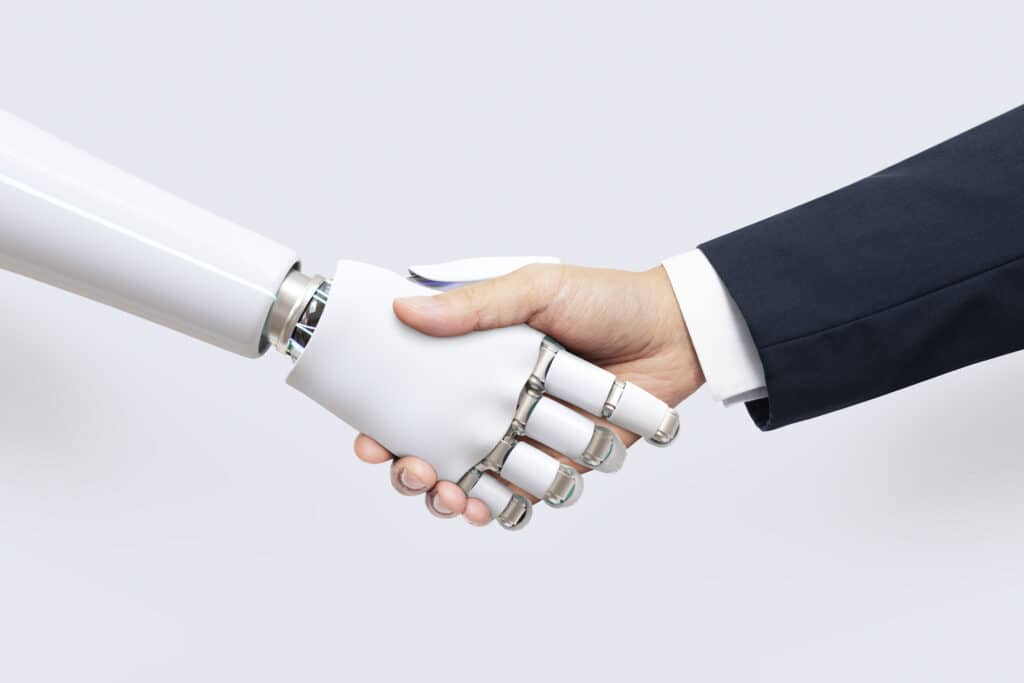If you’re under the impression that artificial intelligence (AI) is just limited to human-like robots, fancy gadgets, and modern assembly lines, you’re giving it less credit than due. AI also impacts search engine optimization (SEO), allowing businesses to achieve their goals with what many call AI conversion rate optimization.
Although SEO, in general, comprises many different processes, conversion rate optimization (CRO) remains one of the most crucial SEO processes. This article will introduce you to the use of AI in SEO, and, in particular, we’ll be focusing on conversion rate. This is a critical metric for online businesses regardless of the size, niche, or industry.
What Is AI?
Artificial intelligence or AI is a broad term as it encompasses many different technologies, including machine learning (ML), deep learning, natural language processing (NLP), and computer vision. There’s no specific definition of AI, as it has become such a broad and diverse field. However, at its core, AI is about performing some cognitive tasks better and faster than humans. In other words, AI covers machines and technologies that think and behave like humans but faster and more efficiently.
More importantly, AI has a learning element, where the technology improves by learning without necessarily being programmed to be better. AI funding and market have been continuously expanding over the past decade. The AI startup funding in just the first two quarters of 2021 is higher than that of all four quarters of 2020 combined. This is just one statistic from a pool of numbers that point to the global influence of AI touching almost every field. Businesses are also adapting it to reap the benefits, with as many as 72% responding to a survey called AI a business advantage.
Like other fields, AI is also becoming an important part of marketing, sales, and SEO. We’ll discuss in detail later what exactly AI-driven SEO is, but for now, let’s talk about conversion rates and their optimization in detail.
The Basics of Conversion Rate Optimization
Conversion rate (CR) is one of the many analytical metrics used by businesses, especially marketers, to gauge the success of their marketing efforts. For instance, a marketer advertising on Google can use CR to determine how many people converted.
No, we’re not talking about religion here. A conversion is a goal for your lead to complete. For example, if your goal is for the lead to buy a product, the conversion would be the buying action.
Similarly, there are many different conversions online, depending on the business. Signing up for emails, subscribing to a service, and filling a form are all examples of conversions.
What Is a Conversion Rate?
A conversion rate is essentially the percentage of visitors that clicked through and did what you needed them to do. Simply put, it’s the number of visitors who made a conversion divided by the total number of visitors in a particular time frame, for example, an hour, day, or month.
Here’s what it looks like in terms of a formula:
CR = (Number of converting visitors/total number of visitors) * 100
Suppose you have a website that sells pet collars. You run an ad, and 100 people click on it in a day, while six of those people buy a collar for their pet from your website. Here’s what the CR will be:
(6/100) * 100 = 6%
The CR in this example is 6% for that particular campaign and for that particular day. Often CR is calculated for the entire duration of the campaign, which can be months long.
What Is Website Conversion Rate Optimization?
Website conversion rate optimization or simply CRO is the process of improving conversion rate through optimizing your website. It’s the art of increasing the number of conversions for the same traffic. Through CRO, you can make more visitors take the action you want.
Let’s take the previous example of 6% CR for a pet collar retailer. This retailer hires the services of an agency that optimizes its site and campaigns to improve the CR. As a result, the rate goes up to 15 percent. This means 15 of the 100 people converted.
As you can see, CRO can help you increase sales (or any other type of conversion) from the same traffic without needing to increase traffic. That, in turn, increases revenue for your business.
There are many ways to boost CRO, including some that use AI. It’s also important to note that CRO isn’t just about increasing the number but optimizing your overall marketing efforts, improving site design, and even learning about your target audience. CRO isn’t limited to a single campaign or keyword. It’s a whole process that incorporates different processes to deliver better long-term results.
What Is a Good Conversion Rate?
While we’re at it, we might as well discuss what makes a good conversion rate. First thing’s first, CR is highly subjective. There’s no set benchmark as CR depends on the traffic, the specific campaign in question, the business niche, the target audience demographics, and even the industry.
So how do you know if your conversion rate is good? And if it’s good enough, do you even need to optimize it further?
One way to gauge your CR is to compare it with industry averages. For instance, if you’re in the software as a service (SaaS) industry, you should use at least the average conversion rate for similar businesses as a benchmark.
But that’s just a benchmark. You shouldn’t settle; try to go even higher. Even a good CR can be optimized. A good CR is the one that increases revenue and puts money back in your pocket. If the conversions pay back the money you’ve spent on marketing or SEO and then some, you have a good CR on your hands. This could be a number as low as 2%, as long as it increases your business’s revenue and overall profit margins.
AI and SEO
AI has become one of the driving technologies for search engines. By extension, it has become an integral part of SEO, at least for those moving with the times. The majority of search engines, including Google, use AI to show results and ads to search queries. Google is using BERT and Rankbrain algorithms, which are highly sophisticated. You know it works when the average search session lasts only 76 seconds.
This is how AI has become equally important for SEO. If you understand how search engines rely on AI, you can tweak your SEO strategy through AI as well. Take, for example, data analysis, which is a key component of any good SEO strategy. Data analytics today heavily rely on AI to produce meaningful information. From searching for keywords to understanding how visitors interact with your website, analyzing data gives a lot of answers.
How Is AI Used in SEO?
It’s understandable to be confused about how AI and SEO can go together when each discipline on its own is quite complex. While both have unique purposes, AI can empower SEO like nobody’s business.
To make more sense of the use of AI in SEO, here’s how it’s used these days:
Identify Opportunities (Discovering Topics, Keywords, and Content)
When it comes to SEO, most of the process is looking for the right topics and keywords to create content about. This is traditionally a laborious process that can take weeks, if not months. AI can make this stage of SEO incredibly easy. Its ability to find patterns in large pools of data sets allows SEO experts to uncover what searches people are making, what words they are using, and what kind of content they are looking for.
This helps you identify what is trending and working in the industry. More importantly, it helps identify market gaps based on searches to find opportunities to create content that nobody else has created so far. With just a few clicks, a tool can search pages of competitors and look for specific keyword clusters. Then it can find topics that some of the top-ranking sites are covering or keywords they are targeting. This sets a roadmap for ranking better with your web pages and content.
Now, this is just about new opportunities with new content. AI can even help you optimize existing content by comparing with similar better ranking pages and making suggestions accordingly. AI serves as a pillar for content strategy and, by extension, the SEO strategy. If a marketer were to do these tasks manually, not only would it take them eons, the results may not be as accurate or impactful.
Refresh Content
Normally, you would publish some content on your website, maybe optimize it, share it on social media, and then forget about it. Regardless of how it ranks, this old content can be used to help the latest pages rank better quickly.
How? The search engine AI uses link equity to older, good ranking pages to bring forth newer pages. Search engines are now looking for the latest, most updated content. That’s not to say that old content cannot rank well and get good conversions. In fact, maturity can actually help a page rank better. However, AI effectively allows for the optimization of both old and new content.
Voice Search
Most search engines now give the option of voice search, in addition to text search. They use highly sophisticated AI technologies like ML and NLP to process voice commands and produce the most relevant results. Over the years, they have improved these algorithms significantly, which means an effective SEO strategy would also need to accommodate voice searches.
Again, this AI-heavy use of search engines can be answered with AI-driven pages and content optimized for voice commands. With the help of the right tools, a marketer can optimize content for voice searches. For instance, they can test how the content reads for a voice assistant.
Automation
Automation has been a major advantage of AI. The mundane, repetitive tasks have been automated, which has resulted in businesses focusing on bigger things. It’s safe to say that it’s also automated many SEO-related tasks. As mentioned before, many search and data analysis tasks are now completely automated, eliminating the need for people to do these tasks manually. Not only does it save time and costs, but it also increases efficiency.
AI Conversion Rate Optimization
AI, especially ML, can help improve the process of CRO. Here are three ways how:
Product Learning
Machine learning uses algorithms that constantly learn to get better. This can be done in two ways: either you can set some attributes to learn or allow the algorithm to create its own attributes, which gives a lot more flexibility.
Your conversions can be improved with tools that learn how much traffic there is, where it comes from, and how many convert. For those that are not converting, where are they exiting the conversion funnel?
Predictive Design
Some AI algorithms can also make predictions, which can be useful when launching something new or running a fresh campaign. The algorithm can test the page design, including headers, font, images, call-to-action (CTA), and other elements.
These algorithms can use analytical data and testing to predict which design would fare well with your audience and have a higher chance of converting. As a result, the optimization process begins right from the start.
Behavior Learning (Deep Learning)
Many platforms observe and analyze their audience’s behavior on their website by using deep learning. Things like how much time they spend on a particular page or even a section of a page can help businesses understand where their website is doing well and where it needs more work.
This is quite a complex process with a very specific approach yet to become popular. However, many retailers already use such tools with underlying deep learning algorithms without compromising sensitive data collected from consumers.
AI-Powered CRO Process
So how can you use AI conversion rate optimization to your advantage? Well, it all begins with understanding that this is an ongoing process because you need to keep striving for better CR.
Do Your Homework
Many businesses start right away with the CRO practices without doing due research. Remember, a major theme of AI CRO is learning. This is important because you need to figure out what is lacking in your website and what may work for your business, in particular. It will answer some really important questions as to why you have a low CR.
Analytics
This is where AI will empower the CRO process even before you’ve made any efforts. Using powerful web analytics tools, collect important data about your website to identify problems with design, navigation, flow, or the content itself. This is especially important if you have a higher click-through rate (CTR) but lower CR. That’s an obvious sign something is wrong with the website design.
Here’s what you need to do with analytics:
- Collect and compare bounce rates for different web pages to see which perform better and which need optimization.
- Analyze your average page loading speeds, especially for the landing pages, as slow pages can bring down your CR.
- Check loading speeds and website performance on different browsers (Chrome, Mozilla Firefox, Microsoft Edge, Safari, etc.), platforms (desktop and mobile), and even specific brand devices like iPhone, iPad, Samsung, or Chromebook.
- Find out where in the conversion funnel people are leaving the most.
- Use heatmaps and mouse tracking to learn how users interact with the website and behave.
You can use so many tools for web analytics, including the free Google Analytics platform.
Feedback
While this is not a new approach, AI can make collecting feedback from your users much easier. And what better way to find out information about your users or their perception of your website than asking them directly?
Using tools like exit surveys and chatbots, you can directly communicate with the visitors and ask them how they found the experience or why they are leaving the website. Through these efforts, the data you’ll collect will give you an unequivocal answer to where you need to work more through CRO.
For instance, many shoppers abandon carts when they see high delivery fees or any delivery fee at all. Yes, shipping costs are very important for shoppers. Having an exit survey in place will tell you that your visitors leave because they find the delivery charges high.
User Testing
Back in the day, user testing involved actually observing a user as they used a website, noting their movements and their reactions. All of that has been automated with AI, as there are remote user testing tools that do the whole process online and produce results in a matter of minutes.
Some companies can do this for you and go so far as to note eye movements and not just whether they clicked a button fast enough or not.
Create Your CRO Strategy
With the research phase over, you have enough information to form a solid CRO strategy. You know the problems with the website and the solutions to those problems, thanks to many AI tools.
While strategizing, you need to take into account all the key metrics. The CR is related to other metrics like CTR or return on investment (ROI). This will help you identify exactly which CR needs optimization, which is doing fine, and which should be abandoned.
With all this figured out, you can prioritize which problems you need to resolve first. This can be done by estimating the problem’s impact on your overall CR. For instance, if you’re dealing with a slow loading page, that should be your highest priority. Form a hypothesis for each issue you identified in the earlier stages. For each problem, think of a solution and why the solution would work. You’ll be testing it in the next phase.
Test Your Approach
Testing is crucial for an effective CRO. You can either go for A/B testing or multivariate testing (MVT).
A/B testing is more common for CRO and involves testing conversion on two versions of your website or landing page. Using a tool, you divert half the traffic to one version and the other half to the second version. For instance, you can test the placement of a CTA and see how it affects conversion. The variant with the higher CR is the one to go with.
MVT is similar, except you can test with more than just two versions. This is useful when you’re testing many different elements on the website. Many experts prefer MVT over A/B testing simply because it’s faster and produces more complete results.
As a result, you optimize the whole landing page or even the entire website, which increases conversions.
Conclusion
Whether you’re getting organic traffic from ranking high on search engine result pages or you’ve run a campaign on social media, a bad conversion rate indicates there’s work to be done. AI conversion rate optimization is the answer, as AI uses the power of data, machine learning, and predictive algorithms to identify problems and recommend solutions.
At Redstitch, AI powers website conversion rate optimization, allowing us to take care of everything for you through AI analytics. We can help improve your conversion rate with powerful tools, so your marketing expenses yield a high ROI. Contact us today to find out how we can help your business achieve that perfect conversion rate that many only dream of!



